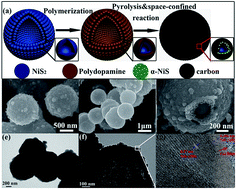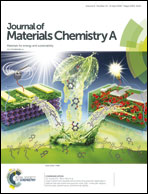A robust hierarchical microcapsule for efficient supercapacitors exhibiting an ultrahigh current density of 300 A g−1†
Abstract
A unique three dimensional (3D) hierarchical microcapsule structure (NiSx@NCV) has been put forward, which is realized by the ensemble of N-doped carbon vesicles encapsulating dual-NiSx (α-NiS/NiS2) nanoparticles via an in situ nanospace-confined pyrolysis strategy. The NiSx@NCV shows a high pseudocapacitance of 1600 F g−1 at 1 A g−1 and impressive rate performance (a capacitance retention ratio of 84.5%, from 1 to 25 A g−1). Benefiting from this intriguing configuration, a kind of high performance asymmetric supercapacitor (ASCs) has been fabricated, using 3D NiSx@NCV microcapsules and nanoporous carbon (NPC) as positive and negative electrodes, respectively. Remarkably, the fabricated ASCs achieve a capability of 135.06 F g−1 at 1 A g−1 and exhibit an outstanding rate capability at 32 A g−1. More importantly, a high capacitance retention ratio of 87% is still achieved even at current densities from 32 to 300 A g−1, which exhibits well the ultrahigh rate performance of the NiSx@NCV//NPC ASCs. In addition, the NiSx@NCV//NPC ASCs deliver an attractive energy density of 48.02 W h kg−1 at a power density of 800 W kg−1, and still maintain 30 W h kg−1 even at an ultrahigh power density of 240 kW kg−1. This is attributed to the rich redox reaction and interface effect of dual-NiSx nanoparticles, abundant active sites and high electrical conductivity from N-doped carbon vesicles.



 Please wait while we load your content...
Please wait while we load your content...